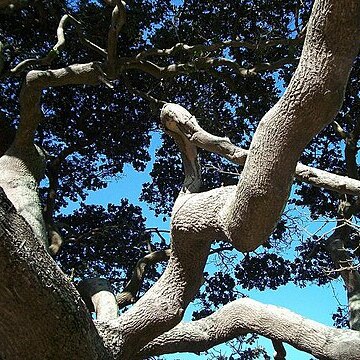A tree. They can be 15-30 m tall. The branches are spreading. The trunk is 60 cm across. The bark is rough and cracked. Young plant parts have red hairs. The leaves are simple and alternate. They are leathery and narrow to the base. They are 1.3-7 cm long by 1-4 cm wide. The edges roll under. They are grey-green above and paler underneath. The leaf stalks are 0.6-1.3 cm long. The flower buds are grouped in the axils of leaves. They are on long, curved, red, hairy stalks. The flowers are white and like stars. The fruit are 1.5-2 cm long and round. They are red when ripe. The pulp is starchy and sweet. The fruit are edible. There is one oval shiny brown seed.
Small tree or shrub, 1-15 m high. Leaves leathery, glossy above, densely and minute brownish appressed-pubescent below, obovate-cuneate or obcordate, distinctly narrowing towards base, usually emarginate or retuse, margins strongly revolute; petioles ± 16 mm long. Flowers white, axillary; pedicels 15-30 mm long. Calyx brownish pubescent, 8 mm long, lobes narrowly whorled, triangular, inner lanceolate, paler and delicate. Corolla: tube 1.5 mm long. Stamens: filaments subulate; anthers 3.5 mm long. Ovary 2.5 mm long; style 6.5 mm long. Flowering time Nov.-Aug. Fruit 1-few-seeded, orange-red. Seeds 13 mm long, with small, circular, basal scar.
Leaves very leathery. Lamina 3–9 x 1·8–4·3 cm., cordate or broadly to narrowly obovate with apex slightly emarginate or rarely rounded–acute; base acute; margin thickened, slightly revolute; petiole 7–16 mm. long. Midrib slightly raised on both surfaces, other nerves faint. Upper leaf surface appressed–pubescent when young, soon glossy, glabrous, lower surface densely and minutely brownish or ferrugineous appressed–pubescent, rarely subglabrous.
Corolla equalling calyx, connate at base into a tube c. 1·5 mm. long; median segments lanceolate with involute margins, lateral segments slightly shorter, each divided almost to the base into two narrowly triangular laciniae.
Calyx c. 8 mm. long; lobes of outer whorl narrowly triangular, brownish–pubescent, those of inner whorl lanceolate, paler and more delicate than outer, with distinct median dorsal groove.
Fruit an edible plum–shaped berry up to 2·5 cm. long, orange–red when ripe; fruiting calyx not reHexed; style persistent.
Young stems greyish or ferrugineous appressed–pubescent, older branches glabrous with striated grey bark.
Stamens c. 5 mm. long; filaments subulate, anthers c. 3–5 mm. long.
Flowers white, borne 1–8 in leaf axils; pedicels 1·5–3 cm. long.
Much–branched evergreen shrub or small tree 1–5(12) m. tall.
Ovary c. 2·5 mm. long; style c. 6·5 mm. long.
Staminodes c. 3·5 mm. long.
Seed 10–13 mm. long.


